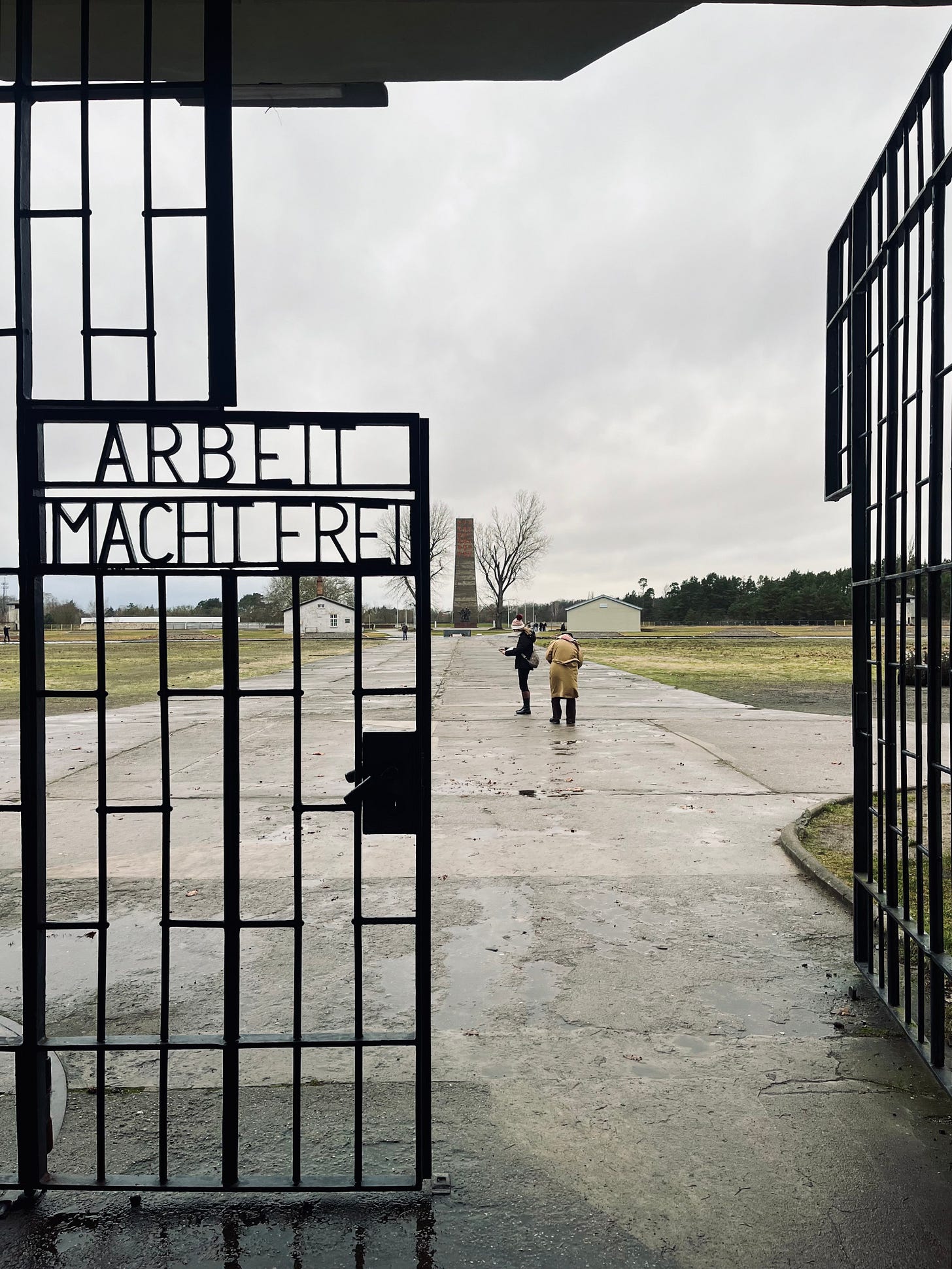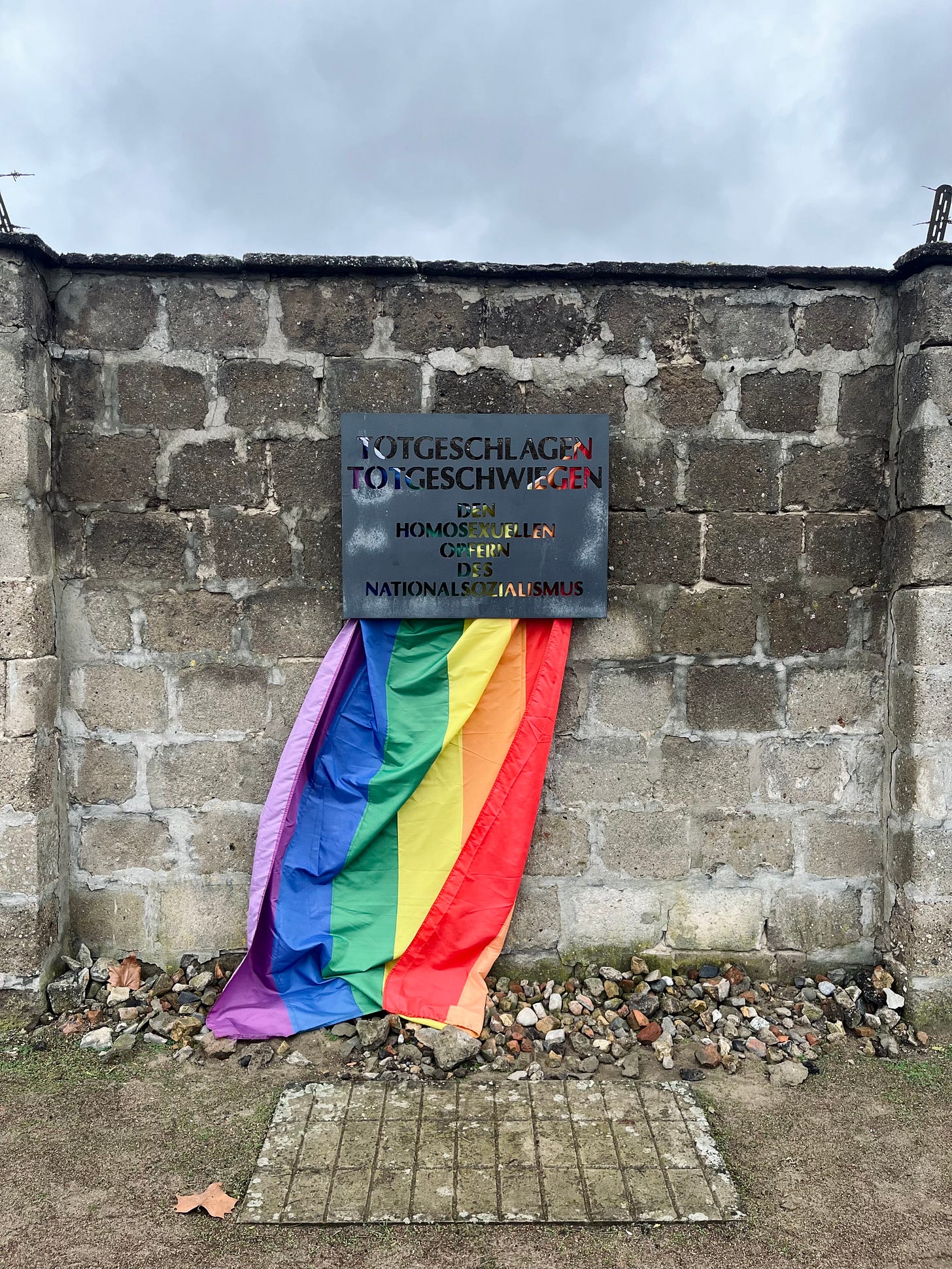Hi writer friends,
Today we have a stunning, poignant essay from writer
, about traveling to Germany to confront the horrors of the past and fears of the present. I won’t waste time on a long intro—this one deserves your first-cup-of-coffee attention. I’ll be back in your inbox later this week.Britany
My Journey to the Future-Past
By G. Samantha Rosenthal
There I was, a Jewish, transgender, temporarily disabled foreigner hobbling on a bum leg where Jewish, transgender, and disabled people eighty years ago were confined and murdered for being these very things.
My therapist has given a name to that place where my body goes when I’m anxious. She calls it the “future-past.” It is where my anxieties about the future—about an all-but-certain hereafter of pain and suffering—exist in a sepia-toned re-enactment of the worst moments from my family’s history.
I told my therapist I was going to Germany to confront it. The past. The Holocaust.
By the end of my second day in Berlin, having walked 17 miles in 24 hours, enthusiastically romping across the city from the Tiergarten to Prenzlauer, my left knee was so fucked up that I wasn’t sure I could even finish my trip. I had not considered that this forty-two-year-old body might fail me.
Yet I kept exploring through the intense pain. I reasoned that pain was a somatic window into a kind of truth about Germany’s history. By the time I hobbled up to the gates of Sachsenhausen Concentration Camp on my fourth day, I had fully arrived. No longer was “the past a foreign country,” as L.P. Hartley once wrote. No, I was now in it, living inside of a terrible nightmare.
There I was, a Jewish, transgender, temporarily disabled foreigner hobbling on a bum leg where Jewish, transgender, and disabled people eighty years ago were confined and murdered for being these very things.
The gates at Sachsenhausen, like at most Nazi camps, feature iron bars spelling the words “Arbeit Macht Frei”: work sets you free. Behind the twisted metal is a large semicircle drawn into the ground. Here the guards marshalled thousands of prisoners each morning. They were forced to stand for hours until they dropped like flies. I hobbled up to the field with my limp leg, gazing toward the gatehouse. I closed my eyes and imagined a cluster of armed guards standing with guns raised. They took one look at me and assessed my utter worthlessness—and shot me dead. Then I opened my eyes.
My next stop was the Jewish quarters, a reconstructed bunkhouse that once confined prisoners who looked like me. A display on the walls features antisemitic propaganda posters depicting people with exaggerated noses. It was crowded inside. Tourists brushed up against one another as we passed solemnly. I thought to myself, most of these tourists do not look Jewish. They thought, oh, look, a Jew. She made it out.
On the other side of the camp, on a stone wall separating the detention center from the killing fields, where tens of thousands were ritually murdered just out of eyesight, I stopped to examine an exhibit on the diversity of the Holocaust’s victims. It was there that I saw her: a photograph of a transgender woman. There was a state police warrant from 1940 calling her a “transvestite.” It said she went around Berlin in “women’s clothing” with a “powdered face” wearing “women’s jewelry.” She was killed at Sachsenhausen. I looked at the woman in the photograph, and I saw myself.
Back at my Airbnb, I was unraveling. Uncontrollably weeping on a FaceTime call with my girlfriend in Virginia, my fight-or-flight response was ramped into overdrive—my psychosomatic nervous system attempting to process what it feels like to be hated, to be disposable, to be killable.
“Everyone was looking at me,” I wailed, snot dribbling down my chin. “And they all thought, Look at that Jew, look at that tranny, that cripple! Look at that freak, that monster! Oh, what a pity. Oh, what a shame.
She tried to calm me down.
“No. No. No,” I pushed back.
After sucking the snot back up into my nose, I added, “I am scared to come home.”
One month earlier, a man many have called a fascist won the presidency in my own country. He promised to usher in a platform that includes stripping transgender people of federal legal recognition as well as access to life-saving healthcare. I had rushed to get all my documents in order before my trip—to make sure that my IDs showed my correct name and sex. I had also begun researching emigration options. My girlfriend feared that I might not even return from Berlin—that I might slip into exile, just as my great-grandparents did, except this time I’d be headed in the opposite direction.
It has been six months since my trip. I came home and ever since, I’ve been struggling to find the right words to write about it. Bags unpacked, the churn of life resuming, I keep opening up my laptop, then closing it again.
Writing is what I do for a living. Before embarking on the flight to Germany, I had pitched The Atlantic (I know, shooting for the stars) with a travel essay headlined “After Trump Won, I Went to Berlin to Learn About Fascism.” It was ham-handed, a gut punch, to the literal point. I never heard back.
My therapist says that I need to get out of my writerly head and start spending more time in my body, feeling the tough feelings: fear, dread, terror, mortality.
She and I consider the following: that I am a transgender person in an anti-transgender world. That I am descended from Jews who escaped antisemitism in Europe—except for my great-grandfather’s cousin, Henri, who was held in a German concentration camp. He died there. That my knee healed. That not everything in life is pain and suffering. That I am capable of, even deserving of, joy and pleasure.
“What does it feel like, in your body, to consider these truths?” she asks.
I sit there stone-faced, eyes closed. Words do not come; only tears.
The transgender, disabled writer Eli Clare argues that body and mind are not separate, but rather one thing, what he calls “body-mind.” This is like the future-past. What we think are distinct phenomena are perhaps one and the same.
I realize that writing about my trip, and the ongoing somatic work I am doing in therapy, are not an either-or equation. Rather, they are both elemental to my experience of grappling with something terrible and profound about our world.
And how we grapple with the profound is always idiosyncratic, oftentimes messy. Reading Jerry Stahl’s Holocaust tourism memoir, Nein, Nein, Nein!, I find myself laughing out loud at his nihilistic take on the absurdity of it all: that in seeking out sites of mass terror and death, he had hoped to move beyond his usual self-loathing. Yet by the end of the book, he still kind of hates himself.
Similarly, I went to Berlin to learn about the past. And, like Marty McFly, I came back to the future. Now I am writing about it. I realize I don’t need to say something profound about Sachsenhausen. Rather my goal is to feel something, and to invite readers into that feeling.
Writing does not heal trauma. Writing does not tie a little bow around something horrifying (like the Holocaust) and make it make sense. Rather, writing is an exploration of, and an attempt to, put feelings into words, and it’s okay if that’s messy.
For six months, I had been searching for a big profound insight about my trip. But now I am satisfied with the indeterminacy of the journey. The world is still a scary place. And I am still here, still scared, still writing.
If you’d like to support the work that goes into this reader-funded publication and help me pay more writers for place-based and travel essays like this one, consider becoming a paid subscriber. Not the right time? A like or share helps Wild Writing reach more readers, too!








